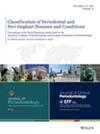在种植体周围疾病中,种植体周围缺氧作为一种潜在的屏障来对抗铁的衰减机制:一项横断面研究。
IF 3.8
2区 医学
Q1 DENTISTRY, ORAL SURGERY & MEDICINE
引用次数: 0
摘要
背景:缺氧通过缺氧诱导因子-1α (HIF-1α)调节炎症和氧化应激。铁死亡是一种铁依赖性细胞死亡过程,由谷胱甘肽过氧化物酶-4 (GPX4)调控,涉及丙二醛(MDA)等脂质过氧化标志物。本研究评估了种植体周围健康、粘膜炎和种植体周围炎期间种植体周围沟液(PICF)中HIF-1α、GPX4和MDA的水平。方法从45名受试者的62颗种植体中采集spicf样本,分为种植体周围健康(PH)组、黏膜炎(PM)组和种植体周围炎(PP)组。酶联免疫吸附试验(ELISA)定量HIF-1α、GPX4和MDA水平。统计分析,包括Kruskal-Wallis和Spearman相关性,评估了生物标志物的差异和关联。结果PM和PP组总MDA水平显著低于PH组(p = 0.014, p = 0.046)。GPX4水平在PM中高于PH (p = 0.034),而在PP中低于PM (p < 0.001)。各组间HIF-1α水平差异不显著,但ph值中HIF-1α浓度显著升高。HIF-1α总量与GPX4呈显著正相关(r = 0.460, p < 0.01)。结论:与种植体周围健康相比,种植体周围黏膜炎和种植体周围炎的GPX4水平升高,MDA水平降低,提示种植体周围环境可能抑制铁下垂。此外,HIF-1α和GPX4水平之间的正相关表明缺氧在调节种植体周围组织的铁迁移途径中具有潜在的调节作用。牙种植体周围的骨质流失会导致严重的问题,危及这些种植体的成功。了解这些问题是如何发展的是预防和治疗它们的关键。在人体中,细胞有时会因铁和有害分子造成的压力而受损和死亡。这个过程被称为“下垂铁”,最近在口腔健康研究中引起了人们的注意。我们的研究着眼于种植牙周围的低氧水平是否会影响这一过程。我们收集了45个人的体液样本,测量了3种与细胞健康和压力相关的重要物质。我们发现,在患病区域,显示细胞损伤的分子水平较低,而帮助保护细胞的物质水平较高。这表明,低氧条件实际上可能有助于通过防止细胞损伤来保护牙齿植入物周围的组织。这些见解可以帮助指导更好的方法来预防和治疗与种植牙有关的问题。本文章由计算机程序翻译,如有差异,请以英文原文为准。
Peri-implant hypoxia as a potential barrier against ferroptotic mechanisms during peri-implant diseases: A cross-sectional study.
BACKGROUND
Hypoxia modulates inflammation and oxidative stress through hypoxia-inducible factor-1α (HIF-1α). Ferroptosis, an iron-dependent cell death process, is regulated by glutathione peroxidase-4 (GPX4) and involves lipid peroxidation markers like malondialdehyde (MDA). This study evaluates HIF-1α, GPX4, and MDA levels in peri-implant crevicular fluid (PICF) across peri-implant health, mucositis, and peri-implantitis.
METHODS
PICF samples were collected from 62 implants of 45 participants categorized into peri-implant health (PH), mucositis (PM), and peri-implantitis (PP) groups. Enzyme-linked immunosorbent assay (ELISA) quantified HIF-1α, GPX4, and MDA levels. Statistical analyses, including Kruskal-Wallis and Spearman correlation, assessed biomarker differences and associations.
RESULTS
Total MDA levels were significantly lower in PM and PP compared to PH (p = 0.014, p = 0.046). GPX4 levels were elevated in PM compared to PH (p = 0.034) but lower in PP than in PM (p < 0.001). While HIF-1α levels did not significantly differ among groups, their concentrations were notably higher in PH. A significant positive correlation was found between the total amounts of HIF-1𝛼 and GPX4 (r = 0.460, p < 0.01).
CONCLUSION
Our findings demonstrated increased GPX4 and decreased MDA levels in peri-implant mucositis and peri-implantitis compared to peri-implant health, suggesting that ferroptosis may be inhibited in the peri-implant environment. Moreover, the positive correlation between HIF-1α and GPX4 levels indicates a potential regulatory role of hypoxia in modulating ferroptotic pathways in peri-implant tissues.
PLAIN LANGUAGE SUMMARY
Bone loss around dental implants can lead to serious problems, putting the success of these implants at risk. Understanding how these issues develop is key to preventing and treating them. In the human body, cells can sometimes get damaged and die due to iron and stress caused by harmful molecules. This process, called "ferroptosis," has recently gained attention in oral health research. Our study looked at whether low oxygen levels around dental implants might affect this process. We collected fluid samples from 45 people and measured 3 important substances linked to cell health and stress. We found that in diseased areas, the levels of molecules showing cell damage were lower, while the levels of substances that help protect cells were higher. This suggests that low oxygen conditions might actually help protect tissues around dental implants by preventing cell damage. These insights could help guide better ways to prevent and treat problems related to dental implants in the future.
求助全文
通过发布文献求助,成功后即可免费获取论文全文。
去求助
来源期刊

Journal of periodontology
医学-牙科与口腔外科
CiteScore
9.10
自引率
7.00%
发文量
290
审稿时长
3-8 weeks
期刊介绍:
The Journal of Periodontology publishes articles relevant to the science and practice of periodontics and related areas.
 求助内容:
求助内容: 应助结果提醒方式:
应助结果提醒方式:


